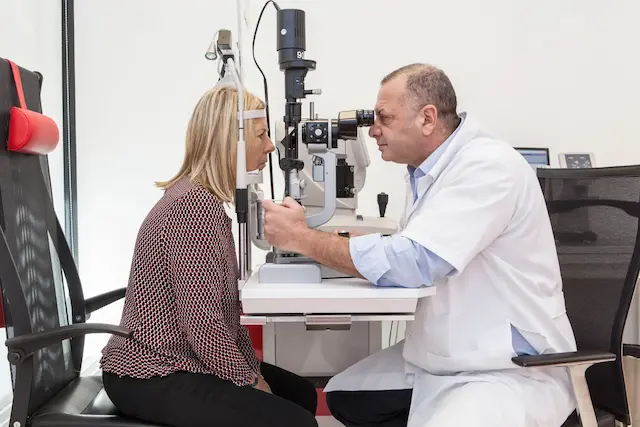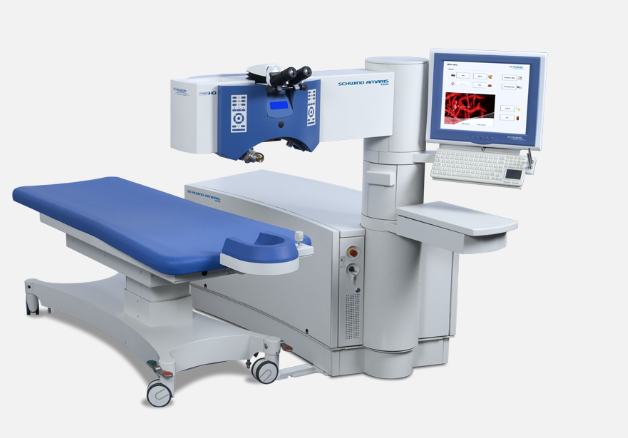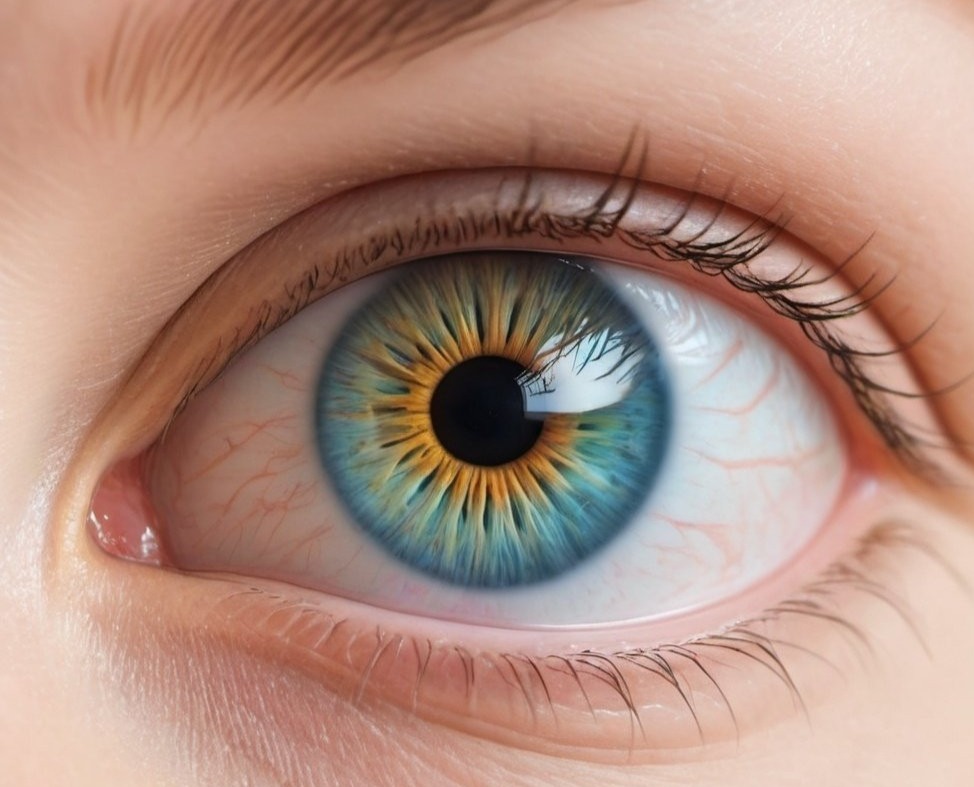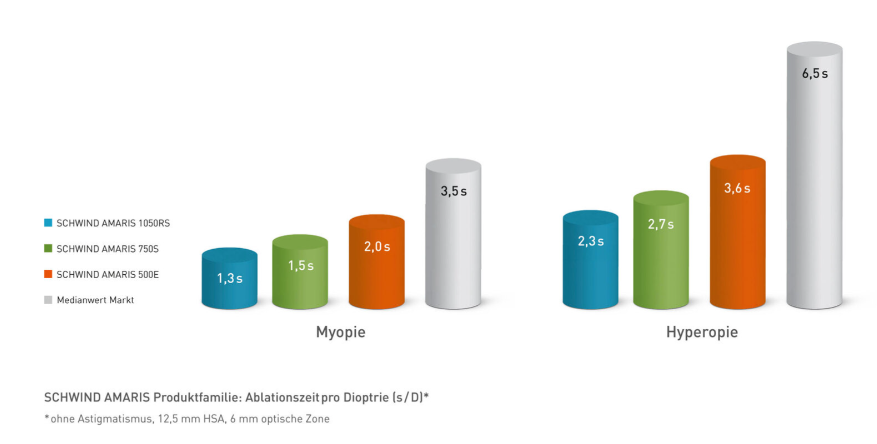
Schwind Amaris 1050Rs Laser
High-performance ocular laser system
The SCHWIND AMARIS 1050RS is one of the world's most advanced ocular laser systems for refractive and therapeutic corneal surgery. It integrates the most advanced existing technologies. With a repetition frequency of 1050 Hz and unique 7D eye tracking, it offers unmatched speed, precision, and safety for laser eye surgery.
Its ultra-thin 0.54 mm laser beam, common to all SCHWIND AMARIS lasers, further enhances precision and smooth corneal modeling

The SCHWIND AMARIS 1050RS
Advanced technical features
Two-level energy ablation
Gentle and precise corneal ablation, thermally optimized for fast and meticulous treatment.
Swiveling laser arm and bed
Facilitates comfort and access for the patient.
7-dimensional eye tracking
Compensates for the smallest eye movements for perfect laser beam positioning.
Real firing frequency of 1050 Hz
All shots precisely reach designated points for optimal correction.
SmartSurFACE: 0.54 mm laser beam
Gentle surface treatment, providing immediate clear vision.
Online pachymetry
Real-time measurement of corneal thickness changes, ensuring treatment safety and effectiveness.
Wavefront treatment
Corrects the cornea while avoiding aberration induction, taking into account the eye's biomechanical properties.
The advantage of wavefront-based correction
Wavefront-guided treatment is designed to correct complex visual aberrations. If higher-order distortions affect your vision, your doctor may recommend wavefront-based technology, which analyzes eye irregularities.
This method allows mapping the light path in the eye, unique to each individual, like a fingerprint. The laser uses this 3D map to precisely correct asymmetric distortions.
SCHWIND corneal and ocular wavefront analyzers detect higher-order refractive errors in the cornea and eye. Combined, they offer a comprehensive diagnosis to identify and treat these errors harmoniously.

Speed and precision with SCHWIND AMARIS lasers
Speed is only beneficial when combined with optimal precision. SCHWIND AMARIS lasers offer a perfect balance between speed and precision thanks to their unique features, ensuring efficient and precise ablation throughout treatment.
The faster the procedure, the lower the risks. SCHWIND AMARIS lasers operate two to three times faster than other refractive correction systems, with up to 1050 light micro-flashes per second to reshape the corneal surface. Ablating one diopter of myopia takes only 1.3 to 2 seconds. The advantage? You only need to focus on the fixation light very briefly, and the cornea is exposed for minimal time, reducing the risk of drying and accelerating visual recovery

Up to 1050 laser shots per second
Automatic energy adjustment
High speed doesn't always guarantee precise results. To address this challenge, SCHWIND has developed a unique method of automatic fluence level adjustment, perfectly combining speed and precision with SCHWIND AMARIS lasers.
Imagine a fast yacht heading to a port, followed by a small boat that positions itself with perfect precision for exact docking. Similarly, SCHWIND AMARIS lasers first use a high energy level to eliminate about 80% of corneal tissue. This phase is continuously adjusted based on the strength of your refractive error. Then, a weaker beam completes the treatment of the remaining 20%, ensuring a perfectly smooth surface and optimal vision.
Laser Beam
SCHWIND AMARIS lasers are equipped with an exceptionally small laser beam, only 0.54 millimeters in diameter, much smaller than those of other systems available on the market.
Moreover, this beam has a "super-Gaussian beam profile," a special shape that allows for a particularly smooth corneal surface. This advanced technology ensures precise and efficient corneal treatment.
Microclimate
Two specially designed nozzles for SCHWIND AMARIS lasers ensure precise and directed airflow, creating a constant microclimate on the cornea. Unlike other lasers, where vacuum cleaners can cause turbulence that dries the cornea and complicates treatment precision, this technology guarantees optimal stability during the procedure.
SCHWIND AMARIS lasers integrate the latest advances in modern laser surgery, offering revolutionary innovations such as two-level energy adjustment for optimal ablation control, a unique seven-dimensional eye tracking system, and an inline OCT pachymeter for real-time corneal thickness measurement.
Safety with Schwind Amaris lasers
For complete peace of mind during laser treatment, SCHWIND AMARIS lasers offer unique features guaranteeing the highest safety standards.

Turbo tracking system
SCHWIND AMARIS lasers combine speed and safety thanks to their innovative eye tracking system.
This system records your eye movements 1050 times per second, ensuring the laser beam remains perfectly positioned throughout the procedure.
Seven-dimensional eye tracking
SCHWIND AMARIS lasers compensate not only for horizontal and vertical eye movements, but also more complex movements such as tilts, rotations and vertical adjustments.
Thanks to an advanced oculometric system, these lasers record and compensate for eye movements with exceptional precision, up to the seventh dimension.
Schwind Amaris 1050RS Laser | Cutting-edge Technology | EASY... | EasyLaser
Imagine the eyeball as a buoy at sea. In calm waters, the buoy moves laterally or back/forth. In bad weather, it can also tilt, roll, and rotate around its anchor.
- 1st and 2nd dimension: Linear displacement
- 3rd and 4th dimension: Rolling movements
- 5th dimension: Rotation around axis
- 6th dimension: Vertical displacement
The seventh dimension takes into account the time factor, compensating for eye movements during the laser system's response time, thus ensuring perfectly synchronized ablation without delay.
Online pachymetry
Online pachymetry continuously measures corneal thickness throughout the surgical procedure. This ensures the cornea remains sufficiently stable after laser correction. Just as a diver uses a depth gauge to monitor their depth underwater, your doctor receives real-time data on your corneal thickness thanks to this system.
Online pachymetry displays corneal thickness changes on a monitor, allowing your doctor to know exactly how much corneal tissue has been removed and what thickness remains. Moreover, this measurement is done without direct contact with the eye, avoiding any physical contact during treatment.
Thermal control
During a surgical procedure, the cornea can dry out if it overheats, which could lead to blurred vision due to the formation of a milky layer. SCHWIND AMARIS lasers are equipped with a unique thermal control system that guarantees effective cooling between each laser pulse, even at high speed. Thanks to this technology, laser pulses are applied at an optimized rhythm, cooling the outer surface of the cornea first before the next one. Unlike other systems, this allows faster application while protecting the cornea from drying out.
Assisted technology for maximum precision
SCHWIND AMARIS lasers provide valuable assistance to the doctor throughout the procedure. Thanks to an ergonomic and intuitive user interface, the surgeon can remain fully focused on your eyes, without being distracted by technical adjustments.
A small screen, located in their field of vision, displays essential information such as laser parameters and program steps.
With a simple button press, they can customize their preferences and activate necessary presets, ensuring a smooth and controlled intervention.
- Screen integrated in the field of vision: display of laser parameters and treatment steps.
- Simple and quick control: settings and presets activatable in a single gesture.
- Ergonomic touch screen: improves navigation and device usability comfort.
- Integrated slit lamp: allows the surgeon to immediately evaluate the ablation result, without changing rooms.